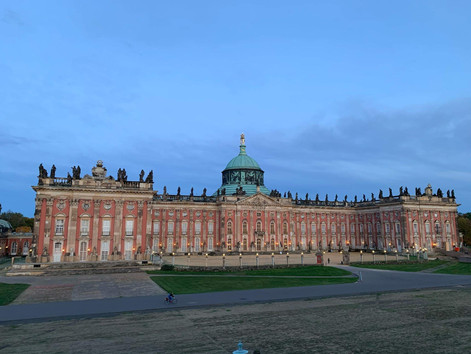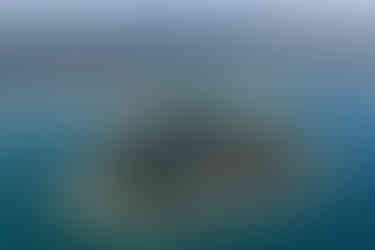Underrated European Travel Destinations
- European Waves

- Feb 27, 2023
- 8 min read
Updated: Apr 6, 2023
Paulina Frank, Manon Heerts, Vivien Keenleyside, Kyra Prins
As the end of winter finally approaches, you might be starting to think about planning some trips for the warmer months ahead. If you are lacking inspiration and are interested in destinations which are slightly more ‘off the beaten track’, then the EPS students are here to help!
Potsdam: A Fairytale City
Vivien
While Berlin is one of the most popular city-break destinations in Europe, its close neighbour Potsdam is often overlooked. It is, however, well worth hopping on the train from the Berlin central station and within less than thirty minutes you can be in the centre of an idyllic and pristine city bursting with history and surrounded by magnificent lakes. Potsdam is the capital of the state of Brandenburg which surrounds Berlin, which is its own city-state. Many might know its name from the Potsdam Conference of 1945, where the Allied powers decided Europe’s post-war fate. It was also the residence of the Prussian kings and the German Kaisers. It therefore is home to numerous impressive palaces. Perhaps the most famous is the Sanssouci Palace, built by Frederick the Great, and it certainly is an unmissable sight to see.

The Sanssouci Park is also home to the Orangery Palace and the New Palace. I can never quite decide which one is my favourite, they are all so beautiful!
I find the range of architectural and cultural influences in Potsdam fascinating; from the Dutch quarter, where houses were built for immigrants coming from the Netherlands in the 18th century; to the Belvedere Palace on the Pfingstberg, inspired by Prussian King Frederick William IV's travels in Italy; to the 'Russian village' which was built at the request of King Frederick William III in memory of his friend Tsar Alexander I.
For the history buffs, I highly recommend visiting the Cecilienhof Palace, which was the venue of the Potsdam Conference of 1945. There is a fascinating exhibition where you can see for yourself the very room where Churchill, Stalin and Truman decided Europe’s post-war fate. Another spot you shouldn’t miss is the Glienicke Bridge, otherwise famously known as the Bridge of Spies. The Havel river, which runs through Potsdam, served as the border between East Germany and West Berlin and it was therefore used for the exchange of captured spies.
Furthermore, fans of French impressionism will enjoy the Museum Barbarini, which hosts an impressive collection, including 38 of Claude Monet’s paintings. Potsdam is also home to the Babelsberg Film Studio, Europe’s oldest and largest film studio, and you can visit the Filmpark Babelsberg, where you can get a fun insight into the world of film and television. If the weather is nice, I can also highly recommend renting a bike and cycling through the city and the surrounding lakes. I really believe that Potsdam has something to offer for everyone, so if you are booking a trip to Berlin sometime soon, make sure to allow time in your schedule for a trip to Potsdam. Or maybe I have been persuasive enough to encourage you to visit Potsdam in its own right!
Lake Constance: All-in-one destination
Paulina
Another place that is pretty underestimated as a travel destination is Lake Constance. This lake is located in the south of Germany and borders both Austria and Switzerland. With a length of 64km and a width of 14km, Lake Constance is the third largest lake in Central Europe and connects three countries.
The lake actually offers almost everything your heart desires: you can go swimming, take a boat trip, go hiking - both on the shore and in the surrounding nature - and the Alps are only a stone's throw away. All along the shore of the lake, small villages and towns stretch out. Situated quite centrally, on a small island promontory, is the city of Constance, which is the largest city on Lake Constance. The city is characterised above all by its historic old town and the magnificent view of the Alps. Fun fact: Constance is right on the German-Swiss border, so you can walk over to Switzerland. As the city is surrounded by water on almost all sides, it is characterised by clean air and a relaxed atmosphere. From the town of Constance, there are countless opportunities to reach other areas around the lake by excursion boats or small ships, or simply to sail around the lake.
The lake itself offers a true paradise for nature lovers. The wide shore and the flat landscape along the water are ideal for jogging, hiking or cycling. In addition, you can go swimming in the summer.
Located right next to Constance is the island of Mainau, also known as the Island of Flowers. The Island holds a large number of Mediterranean plant species and tropical island palms, which can thrive on the island due to the mild climate. Especially in summer, the island is covered with wildflowers and plants and is therefore a very attractive destination for visitors.
Two other highly recommended cities are Friedrichshafen and Lindau.
Friedrichshafen, in particular, is known for its Zeppelin Museum, home to the world's largest collection of airship history and technology, and has a walk-through reconstruction of a part of LZ 129 "Hindenburg". The special characteristic of Lindau is that the old town lies on an island connected to the mainland by two small bridges so the town centre stretches into Lake Constance. A visit is an absolute must in summer, as you can watch the sun go down behind the Lindau lighthouse.
Slovenia: Ljubljana and the Triglav National Park
Manon
Ljubljana, the capital city of Slovenia, has just 280 000 inhabitants and is a lovely small city in the centre of Slovenia.
Its iconic pink monastery is the central point of Ljubljana. In Spring and Summer, this is where there are free walking tours starting every day at 11, 15 and 18. It takes about three hours and you get to see all of the city’s highlights, so it is especially great if you do not have much time.
One of the nicest sights of Ljubljana is Ljubljanski Grad, or Ljubljana Castle. This castle is located on a mountain, giving you a beautiful view of the city. The funicular takes you from the centre of Ljubljana to the castle in just a few minutes, but it is also quite easy to hike up the hill. The castle dates from the 17th century and you can learn more about this castle with a guide or an audio tour. There is also a vineyard not too far from the castle where local Slovenian wines are produced. If you want to make your visit extra fancy, you can do a wine tasting in the castle, tasting all these local wines.
Trubarjeva Cesta is a lovely little alley with street art (very different from all the baroque buildings in the rest of the city), so definitely go check it out if you are a fan. It is also a street filled with nice cosy coffee places and lunch cafes, where you will find many of Ljubljana’s students hanging out.
If you love ice cream (who doesn’t) make sure you make a stop at Cacao. They have so many different, rich and interesting flavours to choose from. The dark chocolate and lavender ones were my favourites.
Triglav National Park
Like I mentioned earlier, Ljubljana is quite small so once you are done exploring, you have the opportunity to explore Slovenia’s national park, the Triglav National Park. The Triglav is the country’s highest mountain peak and forms part of the Julian Alps. You might check out Lake Bled, a very popular tourist destination, but about thirty minutes further away you can find the lake of Bohinj, where many hiking tours start.
You have multiple hiking options in and around the Triglav National Park. I went on a four-day hike through the mountains, staying in some of the mountain huts of the park. The national park has a bunch of different huts where you can stay the night, which makes it (relatively!) easy to go on a multiple-day hiking trip.
But fear not! If a hiking tour of multiple days sounds a bit too scary, there are plenty of one-day options too. The first part of my hike was from the lake of Bohinj through the Slap Slavica valley to the Triglav Seven Lakes hut, a majestic place at 1.200 km. This is a hike that you can do in one day and will take you about 8 hours. The climb is heavy at times, but the reward is absolutely amazing. You can also go to the Triglav Seven Lakes Hut via a slightly different route. If you start at Planina Blato, then the altitude is a bit less, making it an easier climb.
Bulgaria: Sofia - Rila Mountains - Plovdiv
Kyra
Somehow, Bulgaria is not on most people’s list of European travel destinations. When I decided to travel around the country for 3 weeks, people quite seriously asked me why. Those that do decide to embark on the Bulgarian journey often flock to the Black Sea coast to drink their brains away in notorious Sunny Beach or stopover in Sofia for only one night. A pity for a country with such a wealth of nature, history, culture and food to enjoy.
Sofia, located South of the Vitosha mountain, is a great starting point for a trip to Bulgaria. Amongst the many things to enjoy are the trendy culture of nightlife and ‘hidden bars’ where you can enjoy basil cocktails with rakija. Personal favourites were 5L Speakeasy bar, the candlelit only Hambara Bar or the lively garden of bar K.E.B.A. In the daytime, you can immerse yourself in Bulgaria’s rich history with a free walking tour of the city or travel back to 1980s communist Bulgaria with a visit to The Red Flat. Make sure to try a Shopska Salad at least once! Other tasty options are the traditional pastry ‘Banitsa’, cold cucumber soup called ‘Tarator’, or a Bulgarian-styled pancake called ‘Palachinka’.
Within two hours, you can travel from the capital city to the highest mountain region of the Balkan Peninsula: the Rila mountains. The name ‘Rila’ means ‘well-watered mountain’ and dates back all the way to the Thracians. In winter a beloved skiing destination, in summertime perfect for hiking around the seven lakes. Recommended is staying overnight in a lodge on the mountaintop. This way you can include some more hiking, and a visit to the Rila monastery. The spiritual and literary symbol of the Bulgarian Renaissance.
After another two hours by bus, you find yourself in Plovdiv, a place unknown to many people. Surprising, as it is one of the oldest cities in the world, dating back more than 8000 years all the way to the Thracians. This rich historical and cultural heritage can be seen and felt: from Thracians, Greeks, Romans, and Byzantines, to Old Bulgarians, Ottomans, and modern times. Plovdiv’s most ancient remains can be found on top of the Old Town: Nebet Tepe, a beloved spot for locals to watch the sunset. On your way down, you can explore the Old Town of Plovdiv, with cobblestones dating back to the Bulgarian National Revival. Another must-visit is the Ancient Roman Theatre, where you can find tickets for an outdoor theatre show if you are lucky. When you get thirsty, the place to be is the ‘Kapana’ neighbourhood, which means the trap. It does its name justice: leaving Plovdiv’s most atmospheric area full of bars, cafés, and restaurants will be hard, especially after tasting local Bulgarian wines. The perfect place to practise Plovdiv’s famous state of mind: ‘Aylyak’. Derived from Epicureanism, its meaning can be roughly defined as leading a worry and stress-free life, and to be ‘unfazed by the pressures of everyday life’.


















































































Comments